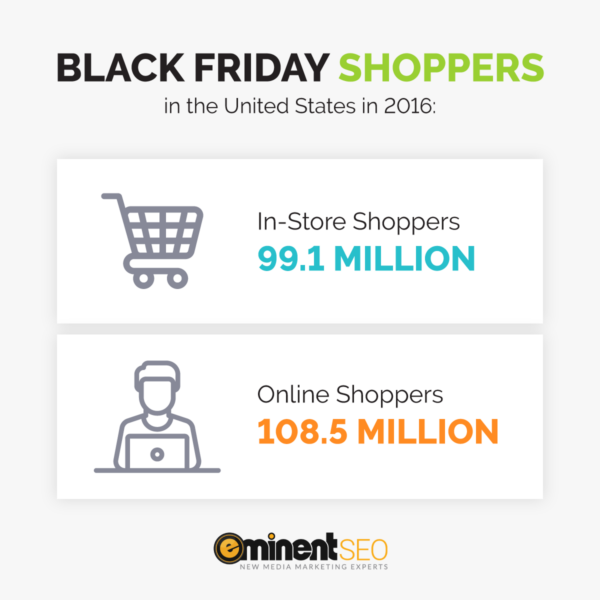The holiday season can bring a nice boost in sales, but it can take a lot of work and extra expense to make it happen. We’ve compiled this guide to help you get the most sales possible from the time and money you invest in your marketing this season.
First, let’s look briefly at what last year’s holiday season sales stats can tell us about the market, and what to expect this year.
A Look Back and Ahead at Holiday Spending
It’s hard to know where you’re going if you don’t know where you’ve been. Before we tell you how to make a holiday season marketing push, let’s take a quick look back at last year’s sales numbers as well as some projections for this year’s November-December rush.
2016 Holiday Season Sales Stats
Last holiday season, online sales in the U.S. raked in a total of $80.2 billion, according to marketing data and analytics firm comScore. When broken out by desktop and mobile purchases, the holiday sales came out to:
- Desktop purchases: $63.1 billion (12% increase over 2015)
- Mobile purchases: $17.1 billion (44% increase)
And worth noting is that the National Retail Federation estimated that nearly 10 million more people shopped online on Black Friday in 2016 than those who shopped in stores that day. The breakdown on Black Friday shoppers last year comes to:
- Online shoppers: 108.5 million
- In-store shoppers: 99.1 million
Black Friday is usually all the talk when it comes to shopping this time of year, but Cyber Monday has actually emerged as the biggest spending day of the year. More shoppers seem to be avoiding the in-store stampedes in favor of the comfort of buying online from home. In 2016, Cyber Monday accounted for $3 billion in online sales – $2 billion via desktop and $1 billion via mobile.
2017 Projected Holiday Season Stats and Trends
With the economy on the rebound, experts are projecting holiday sales this year to grow substantially. Research marketing firm NetElixir predicts a 10 percent increase over last year, which would take total sales from $80 billion to $88 billion. Projections by Deloitte suggest that retail holiday sales in 2017 could exceed $1 trillion.
Online purchases continue to grow compared to in-store purchases. However, many brands are creating campaigns that integrate the online and in-store experiences for customers.
A higher percentage of online purchases are being made on mobile devices. However, desktop sales continue to account for a larger share of the pie, so it’s important that websites are optimized for both types of online buying experiences.
Know What Works

There are a ton of different ways to promote your products during the holidays, so narrowing down your options will help save you time and money and allow you to focus on doing a few reliable things well rather than spreading yourself too thin.
Make a list of best practices in the following areas:
- Audience targets – Which audience segment is your best customer? Where and how do they typically do their shopping during the holiday season?
- Popular promotions – Which products sell well all year? What promotions do your customers always respond well to?
- Previous year’s promotions and sales stats – What worked last year during the holidays, and what didn’t? How can you double down on last year’s successes?
- Best traffic sources – Which lead-generation strategies already work well for you? How can you increase your budget in those areas to gain additional traction during the holidays?
Specific Dates to Target
It’s also a good idea to capitalize on industry-wide shopping dates/promotions that shoppers will be actively looking to take advantage of. Start preparing special promos to meet their needs.
The dates to remember are:
- Thanksgiving Day (Dec. 23 this year)
- Black Friday (day after Thanksgiving)
- Cyber Monday (first Monday after Thanksgiving)
- Green Monday (second Monday in December)
- Free Shipping Day (free shipping with guaranteed delivery by Christmas Eve – Dec. 15 in 2017)
- Holiday weekend (Dec. 22 to 25 in 2017)
- Post-Christmas shopping (Dec. 26 to 31)
Do More of What Works
Once you know what works, it’s time to take those strategies and put them on steroids, so to speak.
Rerun Successful Campaigns, with a Twist
Do what you know works, but try to add a new dimension to it or combine it with other techniques that work to give it a fresh feel.
Highlight Your Most Popular Products and Upsell
Lead off with specials on your most popular products, and offer upsells and add-ons that make sense to increase overall order amounts.
Increase Your Budget for Best-Performing Ads and Channels
Be present on multiple platforms and channels, including social media, PPC, banner ads, emails, radio, TV and print ads. You don’t need to do all of them, but pick a few and do them well.
Optimize for Mobile
Make sure your website is optimized for both mobile and desktop viewing, if it isn’t already.
Set Yourself Apart from the eCommerce Competition – Especially During the Holidays
Differentiating yourself from the competition is always important, but especially so during the holidays when the communications channels are saturated with promotions.
It’s a good idea to know where your products stand in terms of price and shipping cost compared to major competitors like Amazon, as well as compared to more direct niche competitors.
With this information, you can find ways to stand out, including:
- Offering niche products that aren’t easy to find elsewhere
- Combining a service (such as assembly or installation) with certain products
- Loyal customer discounts/benefits
- Top-tier service
- Greater shopping convenience
- Free or upgraded shipping
Time Is Better Than Money
“Time is money,” the saying goes, but for many busy holiday shoppers, time is even more important than money. As you develop your holiday marketing plans, ask yourself:
How will we make it fast, easy and convenient for customers to make gift choices, complete their purchase, and move on to the next item on their holiday to-do list?
19 Quick Holiday eCommerce Sales Tips

-
- Customize offers as much as possible to the individual.
-
- Consider a special landing page of holiday products and special offers. You may want to A/B test offers – for example: price discount vs. free shipping.
-
- Optimize your content and metadata for holiday keywords and write seasonal blog content.
-
- Consider a holiday gift-giving guide, with recommendations for people new to your products (such as friends and family of existing customers) and special or advanced items for loyal customers looking for something new.
-
- Consider creating a limited-run holiday version of a popular product.
-
- Throw in free shipping or upgrades to faster shipping at certain order price points.
-
- Have relatively short windows on specials in order to promote a sense of urgency. Have multiple specials over the course of the season.
-
- Tease special offers and major shopping days a week ahead of time, a day or two before launch, and send emails at midnight on the day of so that they’re in inboxes when customers wake up.
-
- Have a few amazing price deals, but don’t discount so much that it cuts too far into profits. While shoppers are looking for discounts, they’re also looking for convenience. Look for other ways to stand out and win the sale besides simply discounting.
-
- Create specials that encourage upsells and add-on purchases. Throw in free shipping on larger orders.
-
- Let customers know what is the last day to order and get delivery by Christmas. Display this info prominently in website and in email communications.
-
- Incentivize last-minute shoppers with upgrades to faster shipping on large orders.
-
- Use abandoned cart emails to remind them to come back and complete their order.
-
- Encourage people to order early by offering bigger discounts on orders in November and early December. (You may want to share your entire list of holiday specials to prove that the early birds are truly getting the best deals.)
-
- Consider offering specials that allow people to shop from home on Black Friday and even Thanksgiving so they can skip the lines and hassle of brick-and-mortar shopping.
-
- Since Cyber Monday is the biggest day for online sales, offer significant specials and encourage your customers to “buy local” or “support small businesses,” if these descriptions apply to your business.
-
- For last-minute shoppers who’ve missed the by-Christmas shipping window, offer gift cards that can be delivered digitally or printed at home.
-
- If you’re a small business with limited website traffic and marketing budget, consider listing your products or services on major sites like Amazon, Groupon, etc.
- Have a special offer for those looking for post-Christmas deals as well.
Bonus: Tips for Service Businesses
If you’re a B2B service organization, encourage businesses to buy now for 2018, so they can get the tax benefits of purchasing in 2017.
Whether you’re a B2B or B2C service company, considering offering gift cards for future services.
If your services align with things that are typically part of New Year’s resolutions, such as health, love and finances, consider providing a service package that helps them get off to a strong start in the new year and continue their progress through the whole year.
Gift Yourself with Peace of Mind This Holiday Season
Develop a robust marketing plan for the holiday season that will keep you top of mind during this busy buying season while setting you apart from the competition. Don’t leave holiday sales to chance.
For small and mid-sized companies, the key to success during the crowded holiday season is smart marketing and sales strategies that:
-
-
- Capitalize on your company’s strengths
- Target the right prospects
- Allow you to get through to the right people with the right offers
-
You can do all of this even on a limited marketing budget.
Need to get your website ready for what’s left of the holidays? Need help executing a robust holiday campaign? Contact us now to learn how we can help. Time is running out, but it’s not too late to position yourself for success before the year runs out.



